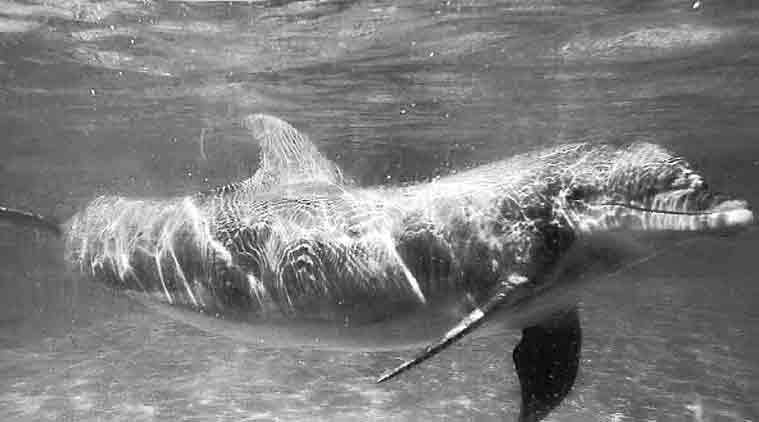Stay updated with the latest - Click here to follow us on Instagram
Counting dolphins in the Ganga
As their numbers fall steeply, the dolphin survey will also help understand the health of the river.
 The dolphin survey is the first step in a long-term conservation plan that was finalised earlier last year and is part of a wider attempt to restore the biodiversity of Ganga. (Source: Reuters)
The dolphin survey is the first step in a long-term conservation plan that was finalised earlier last year and is part of a wider attempt to restore the biodiversity of Ganga. (Source: Reuters)
In the first of its kind exercise, a comprehensive survey will be undertaken in February to assess the population of dolphins in the Ganga river as part of the Clean Ganga Mission. Gangetic dolphins are an endangered species and are now found in only a few stretches of the river.
The dolphin survey is the first step in a long-term conservation plan that was finalised earlier last year and is part of a wider attempt to restore the biodiversity of Ganga. The biodiversity restoration plan is an important, though lesser talked about, component of Clean Ganga Mission, and includes ghariyal and turtles, along with some varieties of fish.
“Dolphin is an indicator species. Its number and distribution is an indication of the health of the Ganga river. Like the tiger in the forests, the dolphin is at the apex of the food chain in its habitat,” said Prof R K Sinha of Patna University, who has been working on conservation of dolphins for over three decades now.
Dolphin conservation has not figured in earlier attempts to clean the river — the Ganga Action Plan phase-I and phase-II were more focused on sewage treatment — though it was being run as a separate programme. The dolphin was also named the ‘National Aquatic Animal’ of India in 2009.
The National Mission for Clean Ganga, the agency responsible for coordinating activities to clean the river, recently hired a specialist, Sandeep Behera, to guide its programme to rejuvenate aquatic life in Ganga.
Behera said the last authentic exercise to estimate the population of dolphins in Ganga was carried out in 1982 by a foreign scholar who put the number at more than 6,000. Over the years, pollution has caused a steep decline in the number which, according to recent estimates, is below 2,000.
But more than the numbers, what’s of greater concern, said Behera, is that “across many stretches of the river, dolphins are entirely absent”. “In the past, dolphins were found across the length of the Ganga and in many of its tributaries. They used to be found in the Yamuna as well. The last recorded sighting of a dolphin in the Yamuna in Delhi happened in 1967. Today, they have disappeared from most of the tributaries and are concentrated in very small areas of the Ganga,” he said.
Nearly 50 per cent of the total population of dolphins in Ganga is now in Bihar, according to Prof Sinha of Patna University. He had a higher and more specific estimate of the population of dolphins, at least 3,607 based on recorded sightings till earlier last year.
“But we have not covered many stretches. The survey that we are now going to undertake will cover the entire length of the river and give us a more accurate picture of the numbers,” he said.
All the concerned states — Uttarakhand, Uttar Pradesh, Bihar, and West Bengal — have agreed to participate in the census exercise (Jharkhand, the other state through which the Ganga flows, does not have dolphins). The survey will be repeated in three years to throw a more reliable number.
Sinha said dolphin conservation was entirely dependent on the progress of the Ganga cleaning exercise. “The habitat of dolphins has shrunk drastically because of pollution. In the past, we have found toxic chemicals in the bodies of dolphins. What is needed is a clean and increased flow of water. So far, the Ganga cleaning has focused on engineering interventions, such as construction of sewage treatment plants. What is also needed, in no small measure, is social intervention,” he said.
The Gangetic dolphins are facing a loss of habitat because of a decrease in the flow of water, pollution and excessive siltation. Dolphins breed in deep waters and feed in shallow waters. In the Ganga, excessive siltation has reduced the depth. A number of barrages and hydropower projects has interrupted the flow of water. In addition, the destruction of floodplains has affected the population of small fish which form the main diet of dolphins.
AROUND THE WORLD
Gangetic dolphins are one of the four true freshwater river dolphins found in the world.
Others are found in the Indus river (mainly in Pakistan), Amazon and the Yangtze river in China. The Indus is estimated to have around 1,100-1,200 dolphins. About 20 of this species are believed to be in the Beas river in India. Amazon has plenty of dolphins, their number believed to be in excess of 8,000. The Yangtze river dolphins have not been sighted in the last 10 years and are believed to have gone extinct.
In addition, there are the Irrawady river dolphins which can survive both in fresh water and marine water. A small number of these are found in Myanmar, Indonesia and the Mekong river delta of south-east Asia. A few of them are in Bangladesh and in Orissa’s Chilka lake.
Dolphins do not breed in large numbers. On an average, a dolphin gives birth to five or six offspring during its life span, which is about 25 to 28 years.







